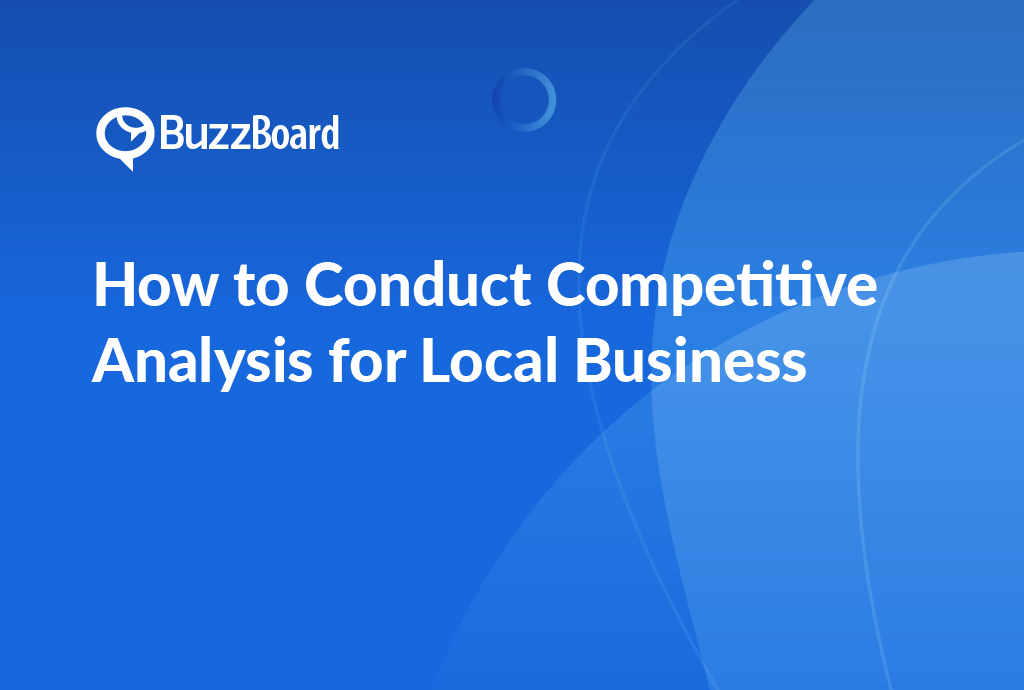How to Conduct a Competitive Analysis for Your Local Business
Conducting a competitive analysis is crucial for local businesses to stay ahead of the competition and make informed decisions. A competitive analysis helps you identify your strengths and weaknesses, as well as those of your competitors. Here’s a step-by-step guide to conducting a competitive analysis for your local business:
- Identify your competitors: Start by identifying your direct and indirect competitors, including online and offline businesses.
- Gather data: Collect data on your competitors’ business profiles, products/services, pricing, marketing strategies, and customer reviews.
- Analyze their strengths and weaknesses: Evaluate your competitors’ strengths and weaknesses to identify areas for improvement and opportunities to differentiate your business.
- Assess their online presence: Analyze your competitors’ website, social media, and online directories to understand their online strategy and presence.
- Monitor their customer reviews: Track your competitors’ customer reviews and ratings to understand their customer satisfaction levels and areas for improvement.
- Use tools and software: Utilize tools and software, such as BuzzBoard, to streamline your competitive analysis process and gain valuable insights.
- Draw conclusions and make adjustments: Use your findings to draw conclusions about your competitive landscape and make data-driven decisions to improve your business.
By following these steps, you can conduct a comprehensive competitive analysis for your local business and gain a competitive edge in your market.
An Introduction to Competitive Analysis for Local Businesses
Competitive analysis is a key component of strategic planning for any business, particularly for local businesses. It assists in recognizing your strengths and weaknesses in relation to the opportunities and risk factors the local market presents and your competitors pose. Viewing competitive analysis for local businesses as an ongoing task, not a one-off endeavor, is crucial.
The aim of a competitive analysis lies in studying your competitor’s marketing strategies, pinpointing their customer base, and comprehending their products or services. This knowledge allows your local business to determine what differentiates your brand and what competitive advantage you have in the market.
As digital marketing professionals servicing local businesses, knowing the market landscape is essential. Possessing a comprehensive understanding of your client’s competitors assists in crafting an effective digital marketing strategy. It’s about identifying where your clients can have a meaningful impact, rolling out strategies their competitors might be overlooking, and aiding the local business in staying ahead in the race.
While competitive analysis may appear as an enormous task for local businesses with fewer resources and smaller teams, precise insights will set them up for success. It’s not about imitating the competition, but understanding the competitive sphere to uncover unnoticed openings and position your clients’ businesses for success.
Please click here for more comprehensive information on how to conduct a competitive analysis. Our digital marketing resources strive to support your team in their endeavors to make local businesses prosper.
The Importance of Competitor Analysis in Boosting the Performance of Your Local Business
Winning local business patronage requires a multifaceted approach that goes beyond simply showcasing your products. While search engine optimization (SEO) and advertising are crucial components of any marketing strategy, few tactics offer greater rewards than a comprehensive competitor analysis. This in-depth examination of your competitors can serve as a guiding compass, helping you navigate your position within the industry and providing vital insights that can reshape your strategic approach.
The primary objective of a competitor analysis is not to outsmart or outmaneuver your competitors, but rather to learn from them and carve out a unique niche for your business. By understanding your competitors’ strengths and weaknesses, you can identify opportunities to differentiate yourself and develop a competitive edge.
To maximize the efficiency of your competitor analysis, it’s essential to consider a range of key variables, including:
- Business size: Understanding the size and scale of your competitors can help you identify opportunities to compete or collaborate.
- Customer base: Analyzing your competitors’ customer demographics, preferences, and behaviors can provide valuable insights into their marketing strategies and customer engagement tactics.
- Product or service offerings: Examining your competitors’ product or service portfolios can help you identify gaps in the market and opportunities to innovate.
- Pricing strategies: Analyzing your competitors’ pricing strategies can help you determine whether your pricing is competitive and identify opportunities to adjust your pricing structure.
- Marketing tactics: Examining your competitors’ marketing strategies, including their use of social media, content marketing, and advertising, can provide valuable insights into their marketing approach and help you develop a more effective marketing strategy.
- Business growth strategies: Understanding your competitors’ growth strategies, including their expansion plans, partnerships, and investments, can help you identify opportunities to collaborate or compete.
By conducting a comprehensive competitor analysis, you can gain a deeper understanding of your competitors and the market as a whole. This analysis can help you refine your sales pitch, improve your digital marketing strategies, and ultimately, assist local businesses in flourishing in this dynamic digital age.
Moreover, a competitor analysis can also reveal blind spots in your own strategies, unearthing uncharted markets, potential collaborations, resource gaps, and other important business particulars. This analysis can help you:
- Identify new market opportunities: By analyzing your competitors’ strengths and weaknesses, you can identify new market opportunities and develop strategies to capitalize on them.
- Develop targeted marketing campaigns: A competitor analysis can help you develop targeted marketing campaigns that resonate with your target audience and differentiate your business from the competition.
- Improve your digital marketing strategies: By analyzing your competitors’ digital marketing strategies, you can identify opportunities to improve your own digital marketing efforts and stay ahead of the competition.
- Refine your sales pitch: A competitor analysis can help you refine your sales pitch and develop a more compelling value proposition that sets your business apart from the competition.
- Identify potential collaborations: By analyzing your competitors’ strengths and weaknesses, you can identify potential collaboration opportunities and develop strategies to work together to achieve common goals.
The real value of competitive analysis lies not just in being better, but also in being different. As you reassess your positioning, equip yourself with comprehensive competitor insights – the pillar of any successful business strategy – to power up your engagement with local businesses. By conducting a thorough competitor analysis, you can gain a deeper understanding of your competitors and the market, refine your strategies, and ultimately, drive business growth and success.
Steps on How to Conduct a Competitive Analysis for a Local Business
Conducting a comprehensive competitive analysis is a vital component of creating a successful local business. By thoroughly understanding your competitors, you can gain valuable insights into their strategies, strengths, and weaknesses, ultimately enabling you to develop a competitive edge and make informed business decisions.
To begin your competitor analysis, start by identifying your local business competitors. This may include nearby shops, service providers, or online businesses that offer similar products or services to your target market within the same geographic area. Utilize online research tools, such as Google search, social media, and local business directories, to gather information about your competitors. You can also attend local events, visit their stores, or conduct phone or in-person interviews to gather more detailed information.
Once you have a list of your competitors, it’s essential to analyze their marketing strategies. This includes examining their website, social media presence, customer reviews, pricing, and advertising efforts. By scrutinizing these elements, you can gain insights into what marketing strategies are effective for your competitors and which ones may not be yielding the desired results. This information can be used to inform your own marketing decisions and help you develop a unique marketing strategy that sets your business apart from the competition.
Next, investigate your competitors’ product or service offerings. Compare the quality, features, and pricing of their products or services to those of your own business. This will help you identify areas where you can improve or differentiate your offerings to gain a competitive edge. You may also want to consider the customer service and support provided by your competitors, as well as their return and refund policies.
After gaining a solid understanding of your competitors, it’s time to reassess your own business. Identify areas where you can improve or differentiate your products, services, or marketing strategies to gain a competitive advantage. This may involve investing in new equipment or technology, hiring additional staff, or developing new products or services.
It’s essential to note that competitive analysis for a local business is not a one-time process, but rather an ongoing process. Market conditions and competition dynamics are constantly evolving, and it’s crucial to regularly monitor and analyze your competitors to stay ahead of the curve. This may involve conducting regular competitor analysis, attending industry events, and staying up-to-date with the latest industry trends and developments.
By conducting a comprehensive competitive analysis, you can gain a deeper understanding of your competitors and develop a competitive edge that sets your business apart from the competition. This will enable you to make informed business decisions, develop effective marketing strategies, and ultimately drive growth and success for your local business.
Identifying the Key Competitors of Your Local Business and Adapting Strategies
Sales personnel serving small local businesses in digital marketing agencies must possess a deep understanding of the importance of competitor analysis. This crucial aspect of market research enables agencies to develop effective strategies that help their clients stand out from the competition and achieve success in their local business environment.
A comprehensive competitor analysis involves a thorough examination of the market activities of rivals, including their products, services, digital presence, marketing tactics, and customer satisfaction levels. By dissecting these elements, digital agencies can gain valuable insights that inform their strategies and help local businesses differentiate themselves from their competitors.
For instance, by analyzing a competitor’s product offerings, a digital agency can identify gaps in the market that their client can fill, or opportunities to improve upon existing products. Similarly, by examining a competitor’s digital presence, an agency can identify areas for improvement, such as optimizing website design or social media engagement.
Moreover, competitor analysis allows digital agencies to identify ineffective marketing tactics and avoid them, instead adopting strategies that have proven successful for their competitors. This can include identifying successful marketing channels, such as email marketing or influencer partnerships, and adapting them to suit their client’s unique needs and goals.
In addition to analyzing competitors’ current strategies, it is also essential to stay up-to-date with changes in market trends and competitor strategies. This requires ongoing monitoring of industry developments, competitor activity, and market shifts, as well as regular analysis of customer feedback and sentiment.
The primary aim of competitor analysis is to provide valuable insights that enable clients to adapt and thrive in their local business environment. By staying ahead of the competition, local businesses can capitalize on new opportunities, respond to changing market conditions, and maintain a competitive edge.
Competitor analysis is a critical component of digital marketing strategy that requires ongoing attention and analysis. By staying informed about competitor activities, market trends, and customer needs, digital agencies can develop effective strategies that help their clients succeed in today’s fast-paced digital landscape.
How Conducting a Competitive Analysis Can Help Improve a Local Business
Competitive analysis is a vital component of any business growth strategy, particularly for local businesses that operate in a specific geographic area. By conducting a thorough examination of local business rivals, entrepreneurs can gain valuable insights into the market, understand customer preferences, and identify areas where their marketing solutions can stand out from the competition.
A comprehensive competitor analysis is not just about identifying the names and products of rival businesses. It involves a detailed examination of various factors that impact their success, including their customer base, market share, marketing strategies, strengths, weaknesses, and more. This analysis provides a clear picture of the competitive landscape, enabling businesses to develop targeted marketing strategies that resonate with their target audience.
Local businesses can greatly benefit from competitive analysis, as it provides them with valuable insights into the strategies their competitors are implementing. This information can be used to develop robust marketing tactics that attract and retain customers, ultimately driving business growth and profitability. Focused competitor monitoring also exposes shifts in industry trends or consumer behavior, serving as an early warning system that enables businesses to adapt quickly to changing market conditions.
In addition, competitive analysis can help local businesses eradicate guesswork and develop data-driven strategies that are grounded in reality. By analyzing the strengths and weaknesses of their competitors, businesses can identify areas where they can improve and develop targeted marketing campaigns that address specific customer needs.
Digital marketing agencies play a vital role in competitive analysis, as they have the expertise and resources to conduct thorough competitor research and analysis. Salespeople within these agencies must emphasize the importance and advantages of competitive analysis to local businesses, highlighting the benefits of gaining a deeper understanding of their competitors.
By fostering an understanding that knowledge about competitors equals power, digital marketing agencies can better equip local businesses to stay competitive, expand their customer base, and enhance their profit margins. This can be achieved by providing businesses with actionable insights and recommendations that are tailored to their specific needs and goals.
Some of the key benefits of competitive analysis for local businesses include:
- Identifying areas of differentiation: By analyzing the strengths and weaknesses of their competitors, local businesses can identify areas where they can differentiate themselves and develop unique marketing strategies that set them apart from the competition.
- Developing targeted marketing campaigns: Competitive analysis provides valuable insights into customer preferences and behaviors, enabling local businesses to develop targeted marketing campaigns that resonate with their target audience.
- Staying ahead of the competition: By monitoring their competitors’ strategies and adapting quickly to changing market conditions, local businesses can stay ahead of the competition and maintain their market share.
- Improving customer engagement: Competitive analysis can help local businesses identify areas where they can improve their customer engagement strategies, ultimately driving customer loyalty and retention.
- Enhancing profitability: By developing targeted marketing strategies that drive business growth and profitability, local businesses can enhance their bottom line and achieve their long-term goals.
Competitive analysis is a crucial component of any business growth strategy, particularly for local businesses. By conducting a thorough examination of their competitors, local businesses can gain valuable insights into the market, understand customer preferences, and identify areas where their marketing solutions can stand out from the competition. Digital marketing agencies play a vital role in competitive analysis, and salespeople within these agencies must emphasize the importance and advantages of this practice to local businesses. By fostering an understanding that knowledge about competitors equals power, digital marketing agencies can better equip local businesses to stay competitive, expand their customer base, and enhance their profit margins.
Conclusion
Conducting a competitive analysis is a crucial step in staying ahead of the competition and making informed decisions for your local business. By following the steps outlined in this article, you can gain a deeper understanding of your competitors, identify areas for improvement, and develop a strategy to differentiate your business.
Remember to start by identifying your direct and indirect competitors, and then gather data on their business profiles, products/services, pricing, marketing strategies, and customer reviews. Analyze their strengths and weaknesses, assess their online presence, and monitor their customer reviews to gain valuable insights.
Use tools and software, such as BuzzBoard, to streamline your competitive analysis process and gain a competitive edge. Draw conclusions about your competitive landscape and make data-driven decisions to improve your business.
By conducting a competitive analysis, you can:
- Identify areas for improvement and opportunities to differentiate your business
- Develop a strategy to stay ahead of the competition
- Make informed decisions about marketing, pricing, and product development
- Improve customer satisfaction and loyalty
- Increase your online visibility and reputation
In conclusion, conducting a competitive analysis is a vital part of any local business strategy. By following the steps outlined in this article, you can gain a competitive edge and drive growth and success for your business.








